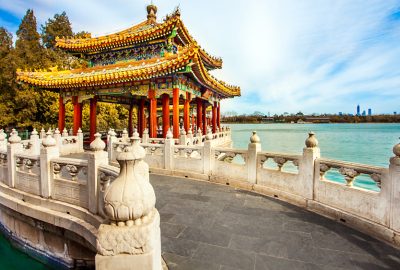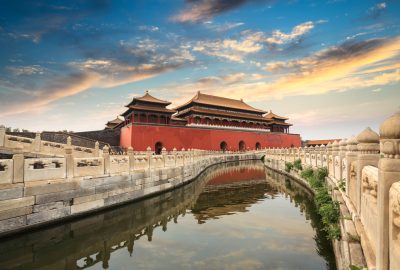China has one of the oldest civilizations in the world. Over 3000 years of documented history is a lot of time. Think of what kind of knowledge and cultural heritage they’ve amassed. Beijing doesn’t capitalize on that. Sure, there are temples, a touch of that ancient legacy, but for the most part, it’s just…vast. China used to have several capitals. Even better, they had numerous capitals at the same time. They had a central city for each of the four regions. Beijing has been an on-and-off northern capital city for over 800 years, throughout different dynasties. In 1949 the People's Republic of China won the Chinese Civil War and claimed Beijing as the regimes seat of power. Mao Zedong and his iconic haircut claimed the prize from the Tiananmen overlooking the Tiananmen Square. It’s one of the largest squares in the world. Communists need that kind of space for their displays of power in the form of military parades. That legendary photo of a guy blocking a column of tanks was made there. Widely known as the “Tank Man”, it’s heavily censored in China for obvious reasons. Regimes don’t like revolutionary symbolism.
Don’t get me wrong: Beijing is beautiful, just like Moscow is beautiful. You wouldn’t necessarily want to live there but you should definitely visit. These countries will do anything to keep up the appearances. Take the Beijing Olympic Park for example. They called it the Olympic Green and it’s huge, very impressive and also very dead. It’s a ghost town. It serves no purpose, at least until the upcoming 2022 Winter Olympics. You can tour the entire complex, including the “Birds Nest” National Stadium, designed by Ai Weiwei. He’s not only a renowned artist but also a big shot anti-government activist. The regime tried to destroy the guy so many times and failed. They eventually allowed him to leave the country and move to Berlin where he currently resides.
The Great Wall is the most recognizable Chinese landmark. There were even rumours about it being visible from space, which is false. Its age, however, isn’t false. Parts of the wall have been standing since the 7th century BC. They built it to shield northern China from skirmishes launched by nomadic tribes. Think how ferocious those attacks had to be that they were forced to build something like this. The combined length of all the walls, including the off-branches, equals to over 20 000 kilometres. And that’s not counting all the barracks, garrisons, armouries, and other defensive structures. You can hike most of it, but try to set out early in the morning to avoid the crowds. Hiring a guide might be a good idea too: they can show you the “less trodden paths”. They’re pretty cheap and often include a meal at a befriended restaurant.
I wouldn’t say that ancient sites like that dominate Beijing’s landscape, but there are quite a few worth checking out. Forbidden City is one of them, it sounds like something from a roleplaying game. There are no dragons to slay, it was forbidden because people couldn’t enter. It used to be the residence of the emperor and royal family for almost 500 years. It’s open to tourists these days but it can be a bit of hustle. First, you need to get past the guys who offer you “alternative tours”. Next, in line are the scammers offering you cheaper tickets. Then you have the people trying to sell you souvenirs and books and all sorts of crap. When you’re past all that and you think you’re good to go, you see the queue to the actual entrance. It’s the world’s largest site comprised of ancient wooden structures, a real treat for students of architecture. You can see the inner chambers too, but only from the corridors, entry is “Forbidden”. It would be one of the coolest sites in the world if only it wasn’t so crowded.
Beihai Park is vis-à-vis with its beautiful lakes and mysterious temples. Great spot to unwind after battling your way through a river of people in the Forbidden City. If crowds don’t bother you then you should visit one of the temples. The Lama Temple is one of the more popular Buddhist sites in Beijing, it has that distinct Tibetan feel to it. Buddhism is fascinating but I could never get deep into that philosophy, the bronze statues are impressive though.

Beihai Park, also known as the North Sea Park or Winter Palace: a public parc and one the largest former imperial gardens of China
Hutongs, the old neighbourhoods, are my absolute favourite part of Beijing. They’re like favelas with best food and drinks, minus the risk of getting shot by a drug cartel. Developers and bulldozers tried to free the precious space to build more heartless apartment buildings. Thankfully they failed and these charming districts are thriving. Some don’t have water, some don’t have toilets, but they have lovely communities. They also cater for the best bars and street food in Beijing: Tiki bars, microbreweries, and even tiny noodle pulling schools. You can expect all that and more in hutongs. Peking Duck is the go-to food if upscale cuisine is your cup of tea. Everyone has their favourite spot but Da Dong at Jinbao St, 88 is universally beloved by both tourists and locals. The waiter brings a cart to your table and cuts the delicious poultry right in front of your eyes. You wrap it up with thin pancakes, dress it up with veggies and sauces and voilà: a Chinese burrito!






No one commented yet. Be the first.